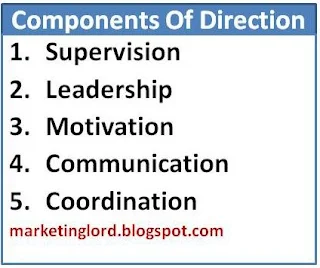Introduction
Direction is one of the most important functions of management. It is directly related with human factor of organization. So, effective implementation of direction is concerned with supervision, leadership, motivation, communication and co-ordination.
The aspects or elements or components of direction are as follows:
1. Supervision
It is overseeing the subordinates at work to ensure that the work is being performed as required. It gives immediate orders and instructions to guide the subordinates at work. It shows the proper way of doing job. Supervision is a means to monitor and control the performance of the subordinates at working place. It is concerned with direct, guidance and control of the subordinates' performances. It is a managerial function. It is generally provided by middle and lower level managers.
2. Leadership
It is a quality of a manager to guide and influence the subordinates at work. It is ability to build up confidence and enthusiasm. It is guiding and influencing subordinates' activities to achieve organizational goals. Direction is closely related with leadership.
3. Motivation
Motivation is a managerial magnet which energizes the subordinates for the different performance. It inspires the subordinates to work. Direction is closely related with motivation. A superior or leader or manager or boss must have motivating power to attract the subordinates at their work while directing. Both financial and non-financial rewards can be used to motivate the employees. Different factors like working environment, nature of job, individual needs and wants, organization's policies etc. affect the motivation. Motivation is the set of forces or factors that cause people to behave in certain ways.
Communication is an essential and important of direction. It is the process of passing message, meaning and information from one person or organization to another. It is a two way process between the sender and the receiver. A superior direction is based on quality and effectiveness of communication. Clear and two ways communication helps to boost-up the effectiveness of direction. So, superior should develop and utilize the effective means of communication. There must be a proper system of communication in the organization.
Also Read:
5. Coordination
Co-ordination is the process of integrating efforts of employees in the organization to achieve organizational goals. Broadly saying, it is the process of linking the activities and efforts of various departments, sections, units and persons to achieve predetermined goals of the organization in a harmonious environment. Different units, sections, and departments may have their own short term and long term goals. Co-ordination connects these all goals into organizational main goals. It unifies all the activities and efforts towards the achievement of central goals. It integrates all the functions of management i.e. planning, organizing, staffing, leading and controlling. It gives synergistic effect to organization by which small coordinated effort produces higher result with minimum cost and time duration. It creates healthy environment in the organization. So, co-ordination is inseparable aspect or component or element of direction.







